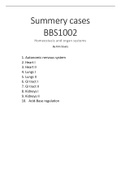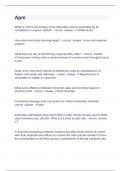Samenvatting
Summary Summery Homeostasis and Organ systems (BBS1002)
- Vak
- Instelling
This summery contains all the cases discussed during the course homeostasis and organ systems (BBS1002). During this course, the tutorial groups talked about the autonomic nervous system, heart, lungs, GI tract, kidneys, and acid-base regulation. In the cases the anatomy, histology and function of ...
[Meer zien]












